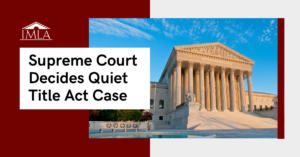29 Mar Supreme Court Decides Quiet Title Act Case
 Yesterday, the Supreme Court held that the Quiet Title Act’s 12-year statute of limitations period is a claims processing rule, rather than a jurisdictional bar to suit. Because local governments are involved in property disputes with the federal government and the Quiet Title Act is the exclusive mechanism for resolving such disputes, this ruling will benefit local governments.
Yesterday, the Supreme Court held that the Quiet Title Act’s 12-year statute of limitations period is a claims processing rule, rather than a jurisdictional bar to suit. Because local governments are involved in property disputes with the federal government and the Quiet Title Act is the exclusive mechanism for resolving such disputes, this ruling will benefit local governments.
The Quiet Title Act, 28 U.S.C. §2409a provides a waiver of sovereign immunity for the United States, stating: “The United States may be named as a party defendant in a civil action under this section to adjudicate a disputed title to real property in which the United States claims an interest, other than a security interest or water rights.” The Act provides for a 12-year statute of limitations, indicating that accrual occurs “on the date the plaintiff or his predecessor in interest knew or should have known of the claim of the United States.” § 2409a(g).
In this case, Larry Wilkins and Jane Stanton both live along Robbins Gulch Road in rural Montana. The road runs near a National Forest and crosses private property for approximately one mile (including their property). Wilkins and Stanton acquired their properties in 1991 and 2004, respectively. The previous owners had granted the United States an easement for Robbins Gulch Road in 1962.
In September 2006 the Forest Service put up a sign on Robbins Gulch Road indicating public access on the road was allowed. Since then, Wilkins and Stanton claim trespassers have been on their land, causing serious disruptions to the homeowners (including shooting one of their cats). In August 2018, Wilkins and Stanton sued the United States under the Quiet Title Act “to confirm that the easement does not permit public use of the road and to enforce the government’s obligations to patrol and maintain the road against unrestricted public use.”
The United States argues that the Act’s 12-year limitation period renders the petitioners’ suit jurisdictionally barred as they sued more than 12 years after they knew or should have known about the claim. The Petitioners argue that the time limit is a non-jurisdictional claims processing rule, which would allow their suit to proceed.
In a 6-3 decision authored by Justice Sotomayor, the Supreme Court agreed with the Petitioners and held that the statute is a non-jurisdictional claims processing rule. The Court noted that a procedural rule “seek[s] to promote the orderly progress of litigation” while “[l]imits on subject-matter jurisdiction…have a unique potential to disrupt the orderly course of litigation.” Jurisdictional bars go straight to the Court’s subject matter jurisdiction and can therefore be raised at any time and such bars also preclude doctrines seeking to ensure efficiency and fairness in litigation, like waiver and estoppel. The Court explained that given the disruption to litigation if a rule is labeled jurisdictional rather than claims processing, Congress must provide a clear statement that it wishes to treat a procedural requirement as jurisdictional, and here, no such clear statement was present.
Justice Thomas, joined by the Chief Justice, and Justice Alito dissented.
IMLA filed an amicus brief in this case arguing that the statute of limitations requirement was a claims processing rule. The brief argued, among other things, that finding that the statute of limitations is a jurisdictional bar would impede settlement negotiations as it would prevent the parties from entering into tolling agreements to suspend the limitations period during negotiations. The brief was authored by Daniel Bromberg and Jeffrey Mikoni.
To read the decision, click here.



